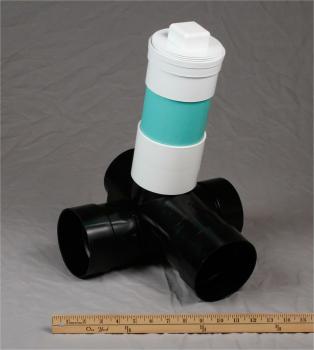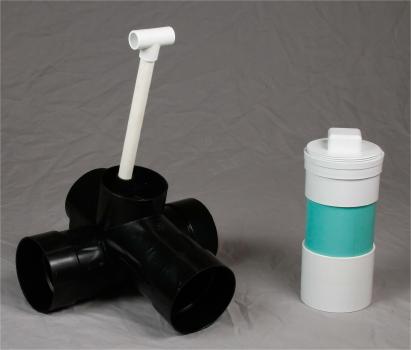Non-electric greywater disposal systems for over 30 years
Greywater or graywater is household waste water from all household plumbing fixtures except toilet and garbage disposal, which is considered blackwater. Rural homeowners with individual sewage disposal septic systems commonly divert at least washing machine water away from their septic tank. With less water passing through, the septic tank has more time to digest waste and settle-out solids. Plus, soaps and detergents have a negative effect on beneficial bacteria health. Diverting graywater away from your septic system leach field reduces loading, increasing waste treatment effectiveness and greatly extending system life expectancy. Phosphate rich soaps and cleaning chemicals are pollutants when discharged directly into waterways, primarily because they accelerate algae growth, which in turn leads to oxygen depletion for fish and other marine life. The beauty of this 'pollutant problem' is mild household cleaning supplies are excellent sources of liquid fertilizer for plant nutrition. Passive, non-electric direct disposal or root-level recycling of greywater with NSF standard 46 filtration conserves ground water while making best use of waste water fertilizer potential.
Sterilizing greywater on-site to the point where it can be reused for above-ground yard sprinklers or flushing a toilet is rarely cost-effective. Should your county require sterilization of greywater effluent to meet local building codes, an economical option may be to add an in-line "automatic chemical feeder" for chlorine cakes. Building department (or your engineer) is responsible for helping you find the correct part, but can be the same as used for chlorinating swimming pools. National Sanitation Foundation NSF/ANSI standard 350 and 350-1 onsite graywater reuse systems exist, but they are complex, expensive toys with way too many electrical components, moving parts, replacement filters, and fixtures that will eventually fail and have to be repaired, then good luck finding replacement parts. And then there is the family health and public liability risk from a poorly maintained NSF350 or 350-1 onsite graywater reuse system when surface watering your lawn. Even drip irrigation systems are not practical due to calcification problems with small spray holes on drip irrigation emitter lines. Greywater IS, however, excellent for reuse in rural passive, non-electric direct disposal or sub-surface root-zone irrigation of trees, privacy hedges, and ornamental planterbeds. Low-tech gravity drainage 'septic' settling filter basin tank systems like our greywater kit, have been standard practice for generations, disposing of used water right back into the aquifer after it percolates through the ground for treatment. It is harmful for septic tank operation to inject phosphate laden, bacteria killing soaps that will disrupt digestive function and force you to have the tank pumped more often.
do-it-yourself greywater design tips and rules of thumb
* Always install a settling basin with filter in-line before leach field or drain pit
* Greywater tank up to 10 feet away and leach fields 20+ feet from foundation
* Avoid exposing greywater tank lids - best to cover with soil, pavers, or mulch
* Always install a cleanout in sewer line near home foundation for servicing
* Slope four inch pipe 1/8 to 1/4 inch per foot, never any steeper before tank
* Bed all pipe and tank in at least six inches of gravel to prevent frost issues
* Never drain directly atop bare ground or spray greywater with yard sprinklers
* When reusing graywater for plants, add nitrogen since that nutrient is missing
* Never use 'septic treatments' as they do more harm than good to leach field
* Use liquid soaps and avoid harsh detergents, bleach, disinfectants & cleaners
* Never install geotextile fabric on the bottom of leach pit or drainage trench
Septic and greywater systems should use crushed washed aggregate, not round river rock. Minimum 'nominal' 3/4 inch is typical and often referred to as a #57 crushed. Up to 1-1/2 inch aggregate can be used, but it gets harder to shovel and may not be quite as effective for septic system effluent treatment. Avoid 'pea gravel', chips and fines, dirt and sand. Avoid using larger gravel or round river rock. Gravel smaller than 3/4 inch will fall through the one inch knock-out holes in side of drywell. Never put gravel on the inside of the drywell, only around the exterior.
While possible for a greywater system to not have a settling filter basin tank and just install two drywells in-series, longevity is always compromised. Grease traps under sinks, filter on the washing machine discharge, and screens in all sinks will help reduce sediment and fats, but not eliminate the need for a settling tank that can be pumped. Your county health department dictates local rules and building regulations, but generally, one must always have a settling filter basin to catch solids and fats. Should local code not apply to your project, it is still very wise practice to prevent particulates from entering the leach field or pits (drywells), forming bio-mat, and eventually clogging soil and stopping percolation. For over 30 years, we have been providing much the same system with excellent feedback. Always check with your building department to confirm local regulations prior to planning any septic (greywater) system to confirm what is required for your property. The Natural Home is not an engineering firm; we do not provide any engineering services, soil testing or on-site work.
"Are we allowed to install this greywater system on our property" or "what size does the leach pit have to be" are not questions we can answer for you. We have been providing much the same non electric greywater system parts for over thirty years now, but we do not follow constantly changing city, county, and state building regulations. The Natural Home is not an engineering firm; we do not provide any engineering services, soil testing or on-site work.
Flow director valve allows one half of your greywater leachfield or orchard to go fallow for a few months to revitalize soil, prevent overloading, and reduce the growth of bio-matting. This is a critical design advantage. Graywater effluent can be split 50/50 between the two outlet pipes OR you can alternate the flow 100% to one side. Valve is designed for gravity flow only, not pressurized pipe (steep slope, long run) or dosing systems with lift station pump or siphon. Click here for flow director details.
Flow director valve pricing, installation details, and design tips
Geotextile soil filter fabric for drainage pits and leach fields
Never install plastic 'visqueen' sheeting or cheap non-woven 'weed barrier' landscaping fabric in place of professional grade heavy-duty woven geotextile fabric for greywater system leach fields or drywell leach pits. Besides longevity, the problem with using visquene plastic sheeting or cheap weed barrier non-woven materials, is they suffocate the soil, ultimately causing anaerobic soil conditions, biomat formation, root rot, and molding issues. Plastic sheeting becomes brittle and tears within a few years and the adhesive bond holding non-woven weed-barrier fabric threads together eventually decomposes, slipping, ripping and tearing, and allowing sand and soil to migrate into the gravel drainage layer of leach field or French drain. Invest in our professional grade woven geotextile fabric with a full 35 mil thickness and extra heavy-duty five ounce per square yard weight and 12 gallons per square foot per minute water permeability. Our superior polypropylene fabric will never rot and will effectively work indefinitely when not exposed to sunlight. Longevity and durability is a function of heavy-duty weight and tough woven construction, versus non-woven weed barrier fabrics which tend to fall apart over the years.
Geotextile fabric pricing, installation details, and design tips



